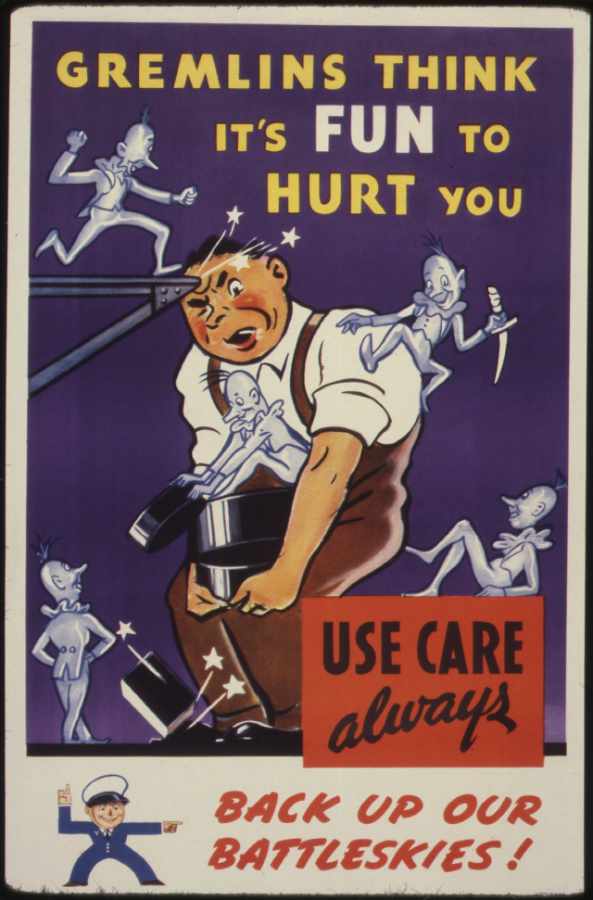A gremlin is a mischievous folkloric creature invented at the beginning of the 20th century to originally explain malfunctions in aircraft and later in other machinery and processes and their operators. Depictions of these creatures vary widely. Stories about them and references to them as the causes of especially inexplicable technical and mental problems of pilots were especially popular during and after World War II. Use of the term in the sense of a mischievous creature that sabotages aircraft first arose in Royal Air Force (RAF) slang among British pilots stationed in Malta, the Middle East, and India in the 1920s, with the earliest printed record in a poem published in the journal Aeroplane in Malta on 10 April 1929. Later sources have sometimes claimed that the concept goes back to World War I, but there is no print evidence of this. Although their origin is found in myths among airmen claiming that gremlins were responsible for sabotaging aircraft, the folklorist John W. Hazen states that some people derive the name from the Old English word gremian, “to vex”, while Carol Rose, in her book Spirits, Fairies, Leprechauns, and Goblins: An Encyclopedia, attributes the name to a portmanteau of Grimm’s Fairy Tales and Fremlin Beer. According to Paul Quinion, it is plausible that the term is a blend of the word “goblin” with the name of the manufacturer of the most common beer available in the RAF in the 1920s, Fremlin.
| Alias Gremlins |
| Real Names/Alt Names N/A |
| Characteristics Trickster, Paranormal Mysteries, Miniature, Occult, Electricity Manipulator, Invisibility, Modernism Era |
| Creators/Key Contributors ○ |
| First Appearance American folklore |
| First Publisher ○ |
| Appearance List Literature: Unknown poem in Aeroplane (10 April 1929), Pauline Gower’s The ATA: Women with Wings (1938), “The Gremlin Question” by Hubert Griffith in Royal Air Force Journal #13 (18 April 1942), “The Gremlins Reform: An R.A.F. Fable” by John Desmond in The New York Times (11 April 1943), Roald Dahl’s The Gremlins (1943). |
| Sample Read Astonishing Legends: Episode 134 Gremlins [YT] |
| Description A gremlin is a mischievous folkloric creature invented at the beginning of the 20th century to originally explain malfunctions in aircraft and later in other machinery and processes and their operators. Depictions of these creatures vary widely. Stories about them and references to them as the causes of especially inexplicable technical and mental problems of pilots were especially popular during and after World War II. Use of the term in the sense of a mischievous creature that sabotages aircraft first arose in Royal Air Force (RAF) slang among British pilots stationed in Malta, the Middle East, and India in the 1920s, with the earliest printed record in a poem published in the journal Aeroplane in Malta on 10 April 1929. Later sources have sometimes claimed that the concept goes back to World War I, but there is no print evidence of this. Although their origin is found in myths among airmen claiming that gremlins were responsible for sabotaging aircraft, the folklorist John W. Hazen states that some people derive the name from the Old English word gremian, “to vex”, while Carol Rose, in her book Spirits, Fairies, Leprechauns, and Goblins: An Encyclopedia, attributes the name to a portmanteau of Grimm’s Fairy Tales and Fremlin Beer. According to Paul Quinion, it is plausible that the term is a blend of the word “goblin” with the name of the manufacturer of the most common beer available in the RAF in the 1920s, Fremlin. |
| Source Gremlin – Wikipedia |

